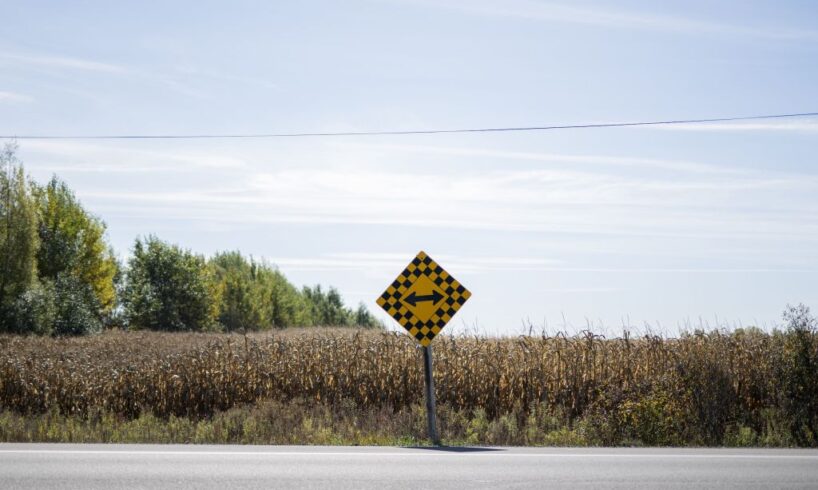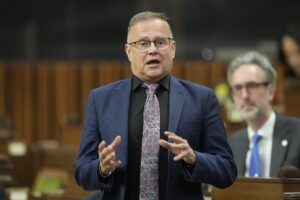
The colourful brochure shows children playing, a community garden and chic retail shops.
It talks about plentiful parks and green building technology. It envisions “walkable and bikeable” spaces. And it promises a “community founded on Algonquin values,” through which the City of Ottawa could “demonstrate a genuine commitment to reconciliation.”
The brochure, from 2020, was making the case for Tewin, a massive development for up to 45,000 people planned for forests and fields southeast of the capital city. A major Ontario developer, Taggart Group of Companies, is behind the project and has partnered with Algonquins of Ontario, which has promoted Tewin as an environmentally friendly example of Indigenous “economic empowerment.”
Members of the Taggart family own a big portion of the land in the Tewin area. But Algonquins of Ontario was largely the face of the project back when they proposed adding it to the city’s urban boundary — meaning it could be connected to municipal services like water and sewers.
“Tewin means home,” Wendy Jocko, then-chief of the Algonquins of Pikwàkanagàn First Nation, told Ottawa city councillors in 2021. “Tewin reminds us that we are at home in our traditional territory and assures us that we can rebuild our meaningful presence on these lands and within the social fabric of this city.”
The Tewin land slated for development is near a cornfield southeast of Ottawa’s centre. While members of the Taggart family own much of the Tewin land, Algonquins of Ontario have largely been the public face of the project. Both the Taggart Group and Algonquins of Ontario are “true financial beneficiaries” of the project, a Taggart vice-president said.
Through corporate filings, The Narwhal has learned two Taggart family members, who are executives at one of the company’s subsidiaries, sit on the board of the Algonquins of Ontario Realty Corp., the private venture established by the Algonquins of Ontario to see Tewin through. The developer and realty company also share the same head office address, the records show.
Michelle Taggart, vice-president of land development at two Taggart Group subsidiaries, Tamarack Homes and Tartan Homes, confirmed the corporate structure in an emailed response to questions from The Narwhal. She said the Algonquins of Ontario had determined members of the Taggart family should be included because of the development experience they bring to the realty corporation’s board.
Algonquins of Ontario had ordered the head office of its realty corporation to be moved to the same location as the Taggart team working on Tewin, she said, so correspondence and other project-related materials could be “received and addressed promptly.” And she noted Taggart is only one of “numerous parties,” along with other private developers, who own land in the larger Tewin “study area” identified by the city.
The Narwhal sent a list of questions to Algonquins of Ontario for this story, but the organization did not respond by publication.
While the Tewin project has already been integrated into the city’s plans, and municipal staff are in the midst of drafting guidelines for next steps, it continues to be dogged by controversy. Everything from the project’s Indigenous and environmental bona fides, to how costly it will be for taxpayers and how much nearby homeowners would actually benefit, has been questioned. City councillors talk about mistrust and frustration boiling up among residents on either side of the debate.
In 2021, the City of Ottawa expanded its urban boundaries, enabling municipal servicing of the Tewin lands. The development has already been integrated into the city’s plans, but it continues to be dogged by controversy as the project’s Indigenous and environmental bona fides are questioned.
The project’s early appeal to reconciliation led to some support from key voices, like the former mayor. But some councillors now wonder if that support was misplaced.
“It was all kind of dreamy, you know, this perfect world that they were going to build,” Ottawa city councillor Theresa Kavanagh told The Narwhal of Tewin’s origins.
“And then we realized that, well, that’s not representative of the Algonquin Anishinaabe First Nations.”
Kavanagh has been leading the charge to kill the project, or at least put it on ice. This month, she put forward a motion to reverse Tewin’s approval. It raised concerns the city might ensnare itself in a potentially costly legal battle with the federally recognized First Nations of the Algonquin Anishinabeg Nation Tribal Council, after several nations said they were not consulted over Tewin.
But if the city pulls the plug on Tewin, it would likely be challenged at the Ontario Land Tribunal, other councillors argue, which has a record of favouring developers.
The Tewin housing development will be located just south of the Ottawa Greenbelt, which is home to many recreational trails that cut their way through forests.
“Either we build, or we hit pause and we let the province come in and take over and do it for us,” Coun. Tim Tierney said during a meeting of the city’s planning committee on Oct. 15. He pointed out the city had already missed its provincially set target for housing construction.
Meanwhile, Algonquins of Ontario’s executive director insists their people have a real claim to being Indigenous, and councillors shouldn’t be in the business of picking which voices count — and which don’t.
Other concerns persist among locals, from questions about how transit-friendly the development is, to whether nearby wetlands can be adequately protected.
In the middle of it all stands Taggart. The development company and its partners, including Algonquins of Ontario, could potentially reap a combined $4 billion in profits from Tewin, according to comments by economist and former public servant Neil Saravanamuttoo to councillors Wednesday.
Asked if she disputed that figure, Michelle Taggart called it “baseless and misleading.”
“We do not engage with unfounded or ill-informed claims made by individuals without relevant knowledge or experience in the private economy or development sector,” she said.
Saravanamuttoo told The Narwhal his estimate was based on typical industry profit margins, along with the expected number of homes sold and the average selling price.
“We probably won’t know whether Tewin was the right decision for many, many years to come.”
Ottawa city councillor Glen Gower
Both the company and Algonquins of Ontario are “true financial beneficiaries,” Michelle Taggart said, and “economic sustainability is part of reconciliation.”
Algonquins of Ontario would benefit from things like scholarships and job opportunities, she said. “Building a community that’s environmentally sound and economically viable is exactly how reconciliation becomes more than symbolism.”
For now, the city will be forging ahead, after councillors voted against Kavanagh’s motion on Oct. 15. It failed on a vote of five to seven, but the controversy over the development seems far from over.
“We probably won’t know whether Tewin was the right decision for many, many years to come,” Coun. Glen Gower said at the meeting.
Some locals see benefits, others worry about sprawl
On a crisp, cloudless Friday, Sushin Malik was busy cashing out gas and lottery tickets for a small lineup of customers.
The area near the gas station and convenience store Malik works at, in the rural Ottawa community of Carlsbad Springs, has seen an uptick of activity since Amazon built a million-square-foot warehouse a few minutes’ drive south.
On the morning of Oct. 10, a brand-new A&W restaurant and a Starbucks next to the Amazon site were bustling with activity.
But what everyone in the neighbourhood was talking about is Tewin, the much larger development set to transform lands to the west.
“If nearby residents increase, then automatically more customers will be here, so it will be good for us,” Malik told The Narwhal.
An Amazon warehouse has already brought an uptick in economic activity to the mostly rural area where the Tewin development is proposed to be built. For Sushin Malik, who works at a nearby convenience store, the prospect of more customers living nearby is appealing. Tewin “will be good for us,” he said.
Carlsbad Springs is surrounded by a handful of homes nestled in fields, forests and wetlands. The area is underlain with a type of clay owing to its geological history as an ancient sea.
The Mer Bleue Bog, the second-largest in southern Ontario and a popular recreation site, lies to the north, beyond which is the large suburb of Orleans. To the west, across Highway 417, there is the neighbourhood of Findlay Creek, and the airport.
Coun. Isabelle Skalski, who was just elected to represent the municipal ward where Tewin would be built, told her colleagues on Oct. 15 she felt people in Carlsbad Springs were divided.
“For some, the promise of improved utilities and new amenities is very exciting. But for others, especially those directly beside the development, there are concerns about construction, traffic flow and negative impacts on their properties and the environment,” she said.
Skalski called Kavanagh’s motion to reverse the Tewin decision an example of councillors “wanting to win a political battle” rather than focus on solutions.
The closest light-rail station is at least a 15-minute drive away from the proposed Tewin development, which means the Trans-Canada Highway will likely be the main connector between the proposed community and Ottawa’s city centre. While Tewin’s developer says it wants to build a “transit-ready community,” critics say the plan will add to Ottawa’s gridlock problem.
At a restaurant neighbouring the Tewin lands, The Narwhal spoke with a worker who was also hopeful the development would drive more customers through their doors. A resident living near the development site said they hoped it might raise property values.
But other nearby residents wondered whether the development would add to the city’s gridlock problem.
Tewin is not your average subdivision: it would see 15,000 homes built on 445 hectares. The development is also far from the city core, and Coun. Shawn Menard has worried it could lock in “forever sprawl.”
The developer says it wants to build the project in order to be a “transit-ready community” and “integrate cycling and transit infrastructure from the start.”
But for now, that means buses: the closest light-rail station is at least a 15-minute drive away. With the city-built and -run transit system already strapped for cash, and suburban bus service in other parts of the city criticized, some argue Tewin could slip into car dependency.
“Infill would be a much better way to go than a project like Tewin,” advocacy group Horizon Ottawa coordinator Tom Ledgley said in an interview.
He said the city’s climate goals as well as transit ridership would benefit more from intensification of the core.
“It’s just the nature of how urban planning goes: if you build things farther out, you are going to have to pay more for services and maintaining things like roads,” he said.
Coun. Tierney said infill isn’t an answer for those who don’t want to live “in a thousand-square-foot box,” he said during the committee debate, but “as a larger family.”
There are also questions about just how much Tewin could cost the city. Staff have said it would cost around $591 million to extend water and wastewater services to the development.
City staff also said Ottawa would pay $11 million of that for benefits to residents, and they expected $314 million of that to be carried by the Tewin project. Coun. Jeff Leiper, who heads the planning committee, said the water pipes needed are just too long and portrayed the development as inefficient.
Taggart said it would fund infrastructure “required to service its community” through development charges and deals with the city.
The proposed Tewin housing development is located west of a provincially significant wetland and south of the Ottawa Greenbelt. A spokesperson for Tewin says it won’t develop on the wetland and will create “appropriate habitat to support local species” as part of its plan. Maps: Shawn Parkinson / The Narwhal
It’s also a community built on green space, and there are worries about how that could be affected. Some of the land directly east of the planned Tewin development is now protected from development as a “provincially significant wetland” following a city evaluation.
Tewin says it won’t develop the South Bear Brook Wetland, as it’s known. “The Tewin team had long identified this area as ecologically significant and supported the findings of that study,” Michelle Taggart told The Narwhal.
She said the company had carried out soil and other ecological studies for years “to ensure the landscape can support the planned growth without harming natural systems.”
North of Tewin, stretching in a U-shape around the city’s core, lies Ottawa’s Greenbelt, home to many trails that snake through forests, showing their fall colours this time of year.
Timothy Gluch, an avid birder, set out in search of a black-backed woodpecker near the proposed Tewin development on Oct. 10, 2025. He said he understands the need for affordable housing, but he’s concerned about the development’s potential to impact bird habitat.
Timothy Gluch, a retired software developer and avid birder, was trying to snag a photo of the black-backed woodpecker along one of those Greenbelt trails when The Narwhal caught up with him.
Gluch said he understood the need for affordable housing, but he was concerned about bird habitat and the increase in traffic.
When told how many residents were expected to live in the development, he exclaimed, “that’s too big.”
Taggart said bird and wildlife habitat had been surveyed and it would be creating “appropriate habitat to support local species” as part of the plan.
An intense debate over who can claim reconciliation
Ottawa is on the unceded territory of the Algonquin Anishinabe peoples, meaning no specific Algonquin nation has a treaty with the Crown, or federal government, in this region.
Traditionally, the Algonquin territory covered what we now call eastern Ontario and southwest Quebec, because the border between the two provinces is a colonial one, imposed much later.
Many of the federally recognized Algonquin First Nations, like Kitigan Zibi Anishinabeg, are north of the Ottawa River in what we call Quebec. One, the Algonquins of Pikwàkanagàn, is in Ontario.
The Algonquins of Ontario, meanwhile, are not a federally recognized First Nation, although the group has made progress with both Canada and Ontario since it began pursuing a land claim in the 1980s.
In 2021, the Yellowhead Institute reported that “10 out of the 11 recognized and established Algonquin communities that make up the Algonquin Nation have expressed deep concerns with the development and legitimacy” of the Algonquins of Ontario. Thousands of self-identified Algonquins have also been removed from the Algonquins of Ontario electorate after their ancestry was disputed.
Chief Vicky Chief of the Timiskaming First Nation, an Algonquin First Nation that’s part of the tribal council Algonquin Nation Programs and Services Secretariat, said councillors should understand Algonquins of Ontario does not represent “legitimate, federally recognized Algonquin rights holders.”
But Algonquins of Ontario say they do represent Indigenous people who have been erased from history due to the Indian Act’s colonial designation of status. First Nations include both “status” and “non-status” Indigenous people; “non-status” means people who identify as Indigenous but can’t be part of the Indian Act’s register.
As such, ever since Tewin was approved in 2021, the project has faced accusations that its claim to reconciliation is flawed.
A small river flows near the rural community of Piperville in Ottawa — an area set to be transformed by Tewin’s 15,000-home housing development.
Kavanagh’s motion to reverse Tewin’s approval said the City of Ottawa “did not appear to satisfy its duty to consult and accommodate” rights-holding First Nations, and instead “mistakenly” consulted Algonquins of Ontario.
Provincial law directs planning authorities to undertake “early engagement” with Indigenous communities on land use planning matters. But only provincial and federal governments have the actual constitutional duty to consult. Under those circumstances, staff said Oct. 15, they had met the legal requirement for Indigenous engagement for Tewin.
But the original concept of the project was presented to councillors as a “true partnership” between Taggart and the Algonquin people, Kavanagh told The Narwhal — and it appears now that the group does not represent the Algonquin Anishinabeg Nation.
Christopher Taggart, president of Taggart subsidiaries Tamarack Developments and Tartan Homes, along with Michelle Taggart, were not on the board of Algonquins of Ontario Realty Corp. at the time city council confirmed Tewin would be in the urban boundary, but joined in December 2022. Same with the head office for Algonquins of Ontario Realty Corp. — it was first registered to a Toronto law firm that represented it, before moving to the same address as Taggart Group’s head office.
That corporate structure suggests Taggart is “just trying to profit off of a development, and there doesn’t really seem to be any legitimate reconciliation goals inherent to the project,” Ledgley, of Horizon Ottawa, said.
Michelle Taggart told The Narwhal the Algonquins of Ontario Realty Corp. was first incorporated in 2018 but “over time, the project transitioned into an active planning and development phase, and the Algonquins of Ontario determined that the board should expand to include members of the Taggart family with development and delivery expertise.”
She said the Algonquins of Ontario moved its office to “the location of the Taggart project management team working on Tewin day-to-day,” so that “any official notices, filings, or project-related materials are received and addressed promptly.”
And she said consultations on Tewin have been comprehensive and ongoing for years, from open houses to technical sessions and “conversations with Indigenous partners.”
Jocko, the former Algonquins of Pikwàkanagàn chief, described Tewin to councillors on Wednesday as an “Indigenous-led initiative.” She said she was speaking as an individual, rather than representing her nation.
The project “addresses critical needs for a growing city” and “offers practical solutions” to the housing crisis, Jocko said.
Municipal services will have to be extended to reach the Tewin housing development at a cost of hundreds of millions of dollars. But it won’t all fall to municipal taxpayers: the company behind the development says it’ll fund the necessary infrastructure through development charges and deals with the city.
“Reversing the 2021 decision would set back housing development planning by four years, and create pressure to find alternative lands elsewhere, at significant cost to taxpayers and with no guarantee of better outcomes,” she said.
Algonquins of Ontario executive director Jim Meness told councillors he felt comments about a failure of consultation “erase decades of work” and negate the opportunity for Tewin to “reverse Ottawa’s colonial legacy.”
“For generations, governments decided who we were, and who we were not,” he said. “Reconciliation is not perfect, it’s not a headline and it’s not a single motion at a committee meeting.”
Due to the alleged lack of consultation with rights-holders, Grand Chief Savanna McGregor of the Algonquin Anishinabeg Nation Tribal Council asked councillors to reject the project entirely, during comments to the planning committee.
Tewin planning will continue through 2027
With the failure of Kavanagh’s motion on Wednesday, work to develop detailed plans for the Tewin community will continue through 2027, according to city staff.
In the meantime, they expected to share a “road map” this fall to give an indication of timing, and to have conversations about service connections with nearby residents.
West of Sushin Malik’s gas station, resident Monica Brewer said she owns two properties at the heart of the Tewin development lands. She hasn’t decided to sell yet, and hasn’t been approached to do so. If she doesn’t sell, Tewin would be built around her.
Brewer, who spoke against Tewin at city hall on Oct. 15, told The Narwhal in a separate interview she had concerns about how such a massive development of houses and roads could affect the environment.
“We love the peace and quiet,” she said.
“And we’ve always been told by the city that these are wetlands, they have to be protected and that they’re environmentally very important.”




